How to Make Kombucha Tea
Kombucha tea
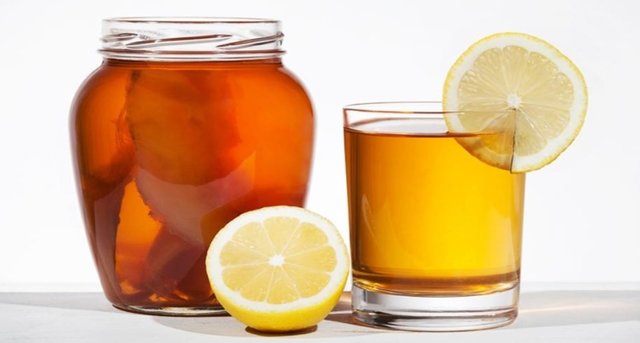.jpg)
Source
Kombucha is a fermented beverage made from tea (black or green), sugar, and a very specific bacteria and yeast culture known as a SCOBY. The tea is said to be high in probiotics, vitamins and other healthy substances that can aid in digestion and the maintenance of healthy gut bacteria in those who consume it. Many people consider it to be a super food.
Though I personally do not know of any research on Kombucha many websites claim that it can boost the immune system, detoxify the body and even aid in weight loss. Some sites suggest that the beverage can reduce an individual’s risk of heart disease, reduce one’s risk of cancer and even manage diabetes.
Though I do personally believe that there are healthy benefits to drinking Kombucha, I am a bit skeptical to some of the more outlandish claims. Some things that individuals should keep in mind when assessing these claims is that Kombucha tea is made differently by different people/companies and that many of the health claims are anecdotal and not based on scientific research. This article discusses some of the properties of kombucha and offers a recipe on how to make it at home. However, please keep in mind that I myself and not a health expert and make no health claims regarding the consumption of the beverage.
SCOBY
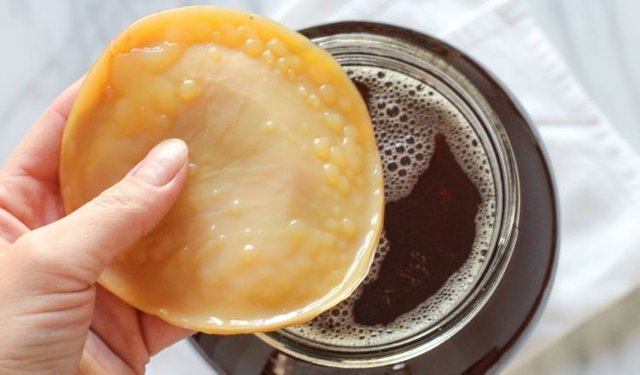.jpg)
Source
The magic of Kombucha tea comes from the fermentation process which occurs when liquid tea and sugar are mixed together with a symbiotic culture of bacteria and yeast (aka SCOBY). The SCOBY is a living organism that is made up of yeast and strains of probiotic bacteria cultures. When placed in a sugary liquid the SCOBY consumes the sugar in the mixture and produce small amounts of alcohol, acetic acid (vinegar) and probiotics. This fermented mixture is then referred to as Kombucha tea.
Because it is a living organism, a SCOBY needs specific conditions in order to thrive. As such, SCOBY’s tend to thrive best when they have access to a food source (i.e. sugar) and when they are kept at room temperature. However, a SCOBY will also survive in a dormant state when placed in cool temperatures like a fridge. Therefore, after a batch of tea has been produced, the SCOBY can be kept in the refrigerator in a small amount of leftover Kombucha tea. There it will remain dormant until a new batch of tea is ready to be produced.
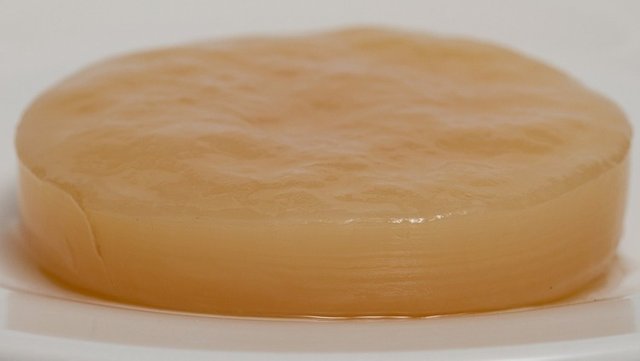.jpg)
Source
A SCOBY will continuously grow each time it consumes sugar, and therefore it can actually be split into multiple SCOBY’s at which point an individual can produce multiple batches of Kombucha. Excess SCOBY’s can also be given to friends, family or co-workers who have an interest in making their own Kombucha.
SCOBY’s can also sometimes be grown from store bought Kombucha tea. However, in order to do this the Kombucha has to be “raw” and unpasteurized (more on this later). Simply add sugar to the raw Kombucha tea and let it ferment at room temperature. After about 10 days or so and if you are lucky, a new baby SCOBY will form at the surface of the tea.
Note: If a SCOBY turns black that means that it has died or become damaged and it’s time to toss it away. I believe the black stuff is mold so I do not recommend consuming tea from a blackened SCOBY.
Probiotics
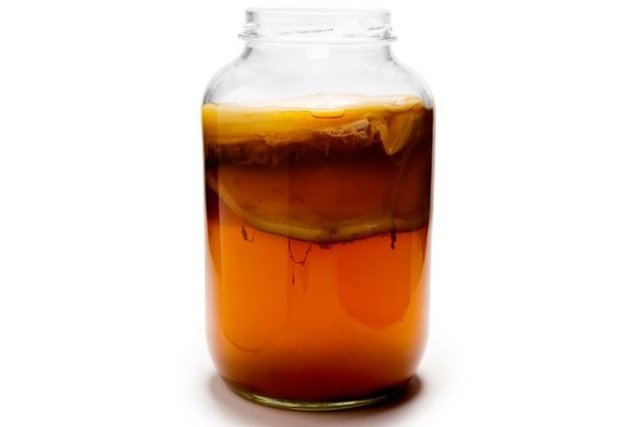.jpg)
One of the main reason why people make and consume Kombucha tea is because of its health benefits, specifically those relating to probiotic bacteria cultures. However, something to consider when choosing a brand of store bought Kombucha or any product that markets itself as a probiotic, is that
just because something is made with a probiotic bacteria culture does not necessarily mean that it contains health benefits associated with probiotics.
Let me explain what I mean by that.
Probiotic bacteria cultures are a living organism and in order to receive the health benefits of the bacteria, the culture needs to still be alive when it is consumed. However, when it comes to store bought Kombucha tea and probiotic food in general, it is common practice to kill off any bacteria in the product before it is sold. Most foods that we buy in the grocery store (i.e. yogurt, milk, beverages…etc) and most Kombucha teas, are pasteurized. The process of pasteurization kills off any bacteria that may make the product spoil as well as any pathogens which may make those who consume it sick. However, since pasteurization kills probiotic bacteria, pasteurized Kombucha teas do not actually have any of the health benefits associated with probiotics. Pasteurized Kombucha tea is essentially just a very expensive beverage.
Keep in mind that sometimes products are marketed with buzz words like "probiotic" in order to make them more appealing. But that does not necessarily mean that the product has any health benefits associated with that particular buzz word. So if you are drinking Kombucha tea for the health benefits associated with probiotics, be sure to make the tea yourself or buy tea that is non-pasteurized. These teas are typically labelled “raw and organic.”
Recipe: Ingredients
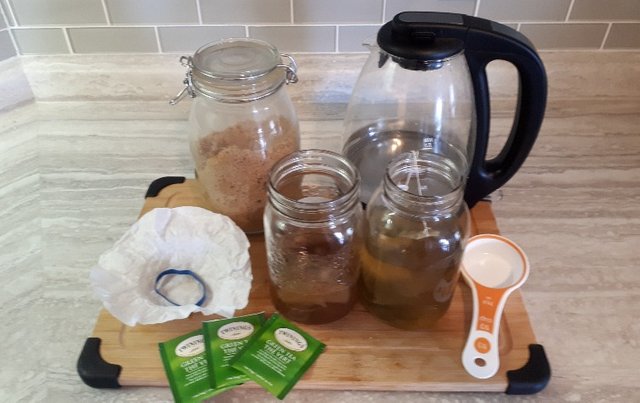.jpg)
The following is a recipe for making Kombucha tea. As you will see there aren’t many ingredients and my measurements are mostly approximations. Kombucha tea is very forgiving and making it does not really require precision or an exact formula. I typically just “wing it” when I make a batch which makes it very easy to produce.
Approx. 1 quart of water (4 cups). The water should be unchlorinated if possible, as chlorine can damage or kill off the bacteria culture
Tea (black or Green). 2-3 bags depending on how strong you like your tea.
White or brown sugar (approx. ¼ cup).
Approx. ¼ cup of starter tea with SCOBY.
Ginger or Fruit (raspberries, strawberries…etc). *Adding additional flavor to the tea is optional.
Directions
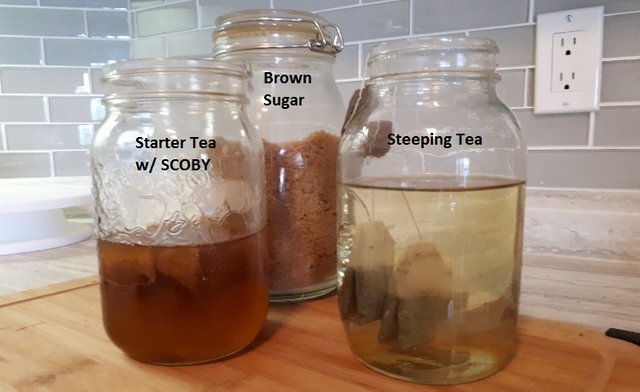.jpg)
First boil water in a kettle or pot.
Place tea bags in the boiled water and let them steep. Add sugar and stir with a plastic or wooden spoon until dissolved. Try not to use anything metal during the Kombucha making process as metal can damage the SCOBY (I believe this is because SCOBY’s are slightly acidic).
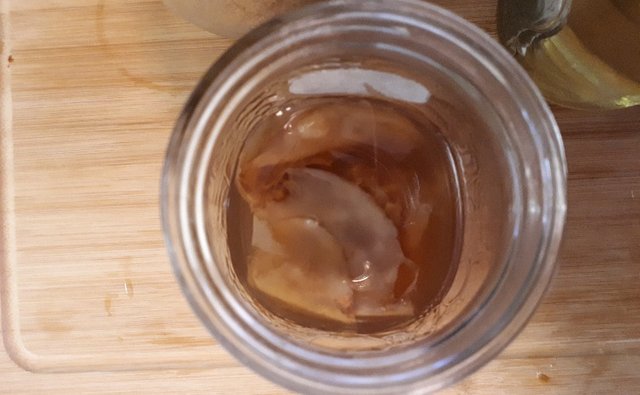.jpg)
Place the mixture in a clean glass jar or jug and let it cool to room temperature. Leave space in the jar for the starter tea and SCOBY. Also, keep in mind that the SCOBY will grow during the fermentation process and if not enough space is left the SCOBY will expand outside of the jar.
Once the liquid mixture is cooled to room temperature, add the starter tea and SCOBY. Place a coffee filter and elastic (or other form of breathable barrier) over the top of the jar and place it in a dark cupboard.
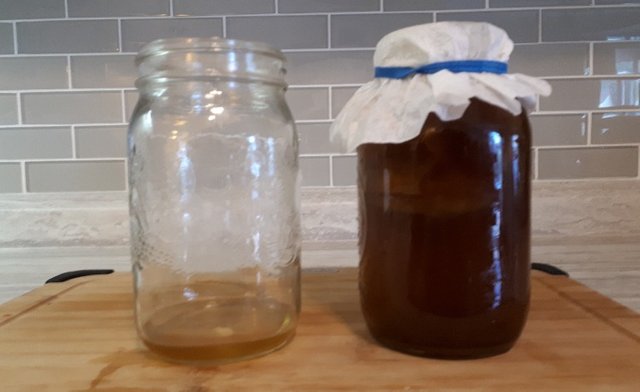.jpg)
Let the tea sit for approximately 7-10 days until it is completely fermented. Sometimes you have to taste the mixture during this process. If it seems to be too sweet then it is not done fermenting and if it starts to taste acidic it means that it has over fermented and is turning to vinegar. If the liquid turns into vinegar it can still be drank, it’s just not as pleasant. When this happens I usually just add a bit more sugar or fruit to cut the acidity.
When the tea has completed its fermentation process it is ready to drink. Strain the tea through a coffee filter to eliminate any residue and so that another SCOBY does not grow in the tea. Put the tea in the fridge and consume as desired.
If you add a bit of sugar or fruit to the tea and seal it under pressure it will ferment a little more and become carbonated.
Start Slow
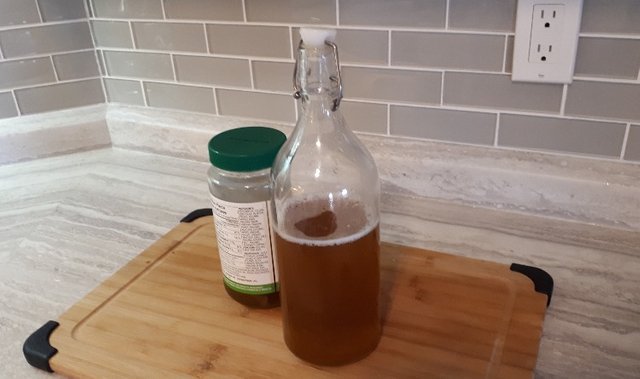.jpg)
One of the characteristics of live probiotics is that it aids in the digestion process. As such, drinking too much of it too quickly can have a similar effect as consuming a laxative. Therefore I recommend starting out slowly when consuming homemade Kombucha. I typically start out with one shot glass full per day and slowly work my way up as my body adjusts.
Congratulations, your post has been selected to be included in my weekly Sustainability Curation Digest for the Minnow Support Project.
Promoter of The SOS Forums : Weekly Discussion Forums on the State of Steem.
Co-ordinator of SteemClub-UK.
Editor of the weekly listing of steem radio shows, podcasts & social broadcasts.
Founder of the A Dollar A Day charitable giving project.
Thanks for the support!
Posted using Partiko Android
We have it constantly brewing. It's a rewarding effort
Posted using Partiko Android
I try to always have a batch going as well
Posted using Partiko Android